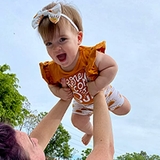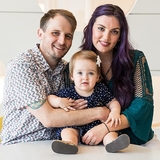Lyra’s Story: Celebrating the 5,000th Baby Born in the Garbose Family Special Delivery Unit
Lyra’s Story: Celebrating the 5,000th Baby Born in the Garbose Family Special Delivery Unit
Like generations of family members before them, high school sweethearts, Tracy and David, were born and raised in Sarasota, Fla. They assumed their daughter, Lyra, would carry on the tradition. But it was Philadelphia, home to one of the most specialized delivery units in the world, that had the honor of being Lyra’s birthplace.

Lyra was a miracle even before surviving a life-threatening prenatal diagnosis. After dating for 10 years, her parents, Tracy and David, got married and were excited to start a family. However, getting pregnant proved more difficult than they anticipated. At one point, Tracy’s OB-GYN even told her she was likely infertile. Nevertheless, the couple kept trying, and after two years, their dream of starting a family finally came true.
It was an exciting time, as Tracy’s two brothers and their wives, who all live in Sarasota, were also expecting. The first trimester was seamless, so Tracy went into her 20-week anatomy scan “expecting nothing but happiness,” she says. She ended up leaving in tears after being told by the ultrasound tech and maternal-fetal medicine specialist (MFM) that there was a growth on the fetus’s tailbone.
The MFM said it looked like a sacrococcygeal teratoma (SCT). SCTs can grow extremely rapidly in utero. As they grow, they steal blood supply from the fetus’s heart, which can cause fetal heart failure (hydrops) and put the baby’s life in jeopardy.
“I just remember bawling for days,” says Tracy. “It was horrible. We had no hope.”
Searching for signs of light

After the diagnosis, Tracy’s mother took to the internet to research SCT. She soon found herself on the web page for the Richard D. Wood Jr. Center for Fetal Diagnosis and Treatment at Children’s Hospital of Philadelphia (CHOP). She was impressed by what she saw. CHOP’s team handles more than 20 SCT cases a year and has the world’s greatest experience performing fetal surgery for the condition, when such an intervention is needed. Tracy’s mom was most inspired by the stories she found on the site that recounted other families’ experiences with a prenatal diagnosis of SCT.
“My mom said, ‘You have to call CHOP. I feel in my heart this is where you need to be,’” recalls Tracy. Taking her mom’s advice, she called the Center and spoke with Fetal Therapy Coordinator and Fetal Therapy Education Specialist, Stefanie Kasperski, MS, CGC.
“After one phone call, I knew we had to do everything we could to get there.”
“The seeds of hope were planted,” adds David.
SCT treatment planning with an experienced team

The couple flew to Philadelphia for their first appointment at the CFDT. At the end of a full day filled with many diagnostic tests coordinated by Kasperski, they met with an attending maternal-fetal medicine specialist and Attending Fetal and Pediatric Surgeon, William H. Peranteau, MD. The physicians thoroughly explained the diagnosis — a Type 2 SCT — and the potential outcomes, and they set realistic expectations.
The goal was to get the pregnancy to 28 weeks’ gestation, hopefully without having to do fetal surgery. However, if the fetus developed hydrops before reaching 28 weeks’ gestation, the team was equipped to perform fetal surgery to remove the SCT in utero.
“They didn’t give us false hope,” says Tracy. “They were very honest that this was extremely high risk and they didn’t know what was going to happen.”
Despite the many unknowns, the team’s confidence and comprehensive approach reassured the couple.
“They were so knowledgeable, with Plan A, Plan B, Plan C,” says David. “At the end of the appointment, they said, ‘We’ve got you now,’ and that made us feel better.”
“I knew we were in the right hands,” adds Tracy. “I would do anything and everything I could for my daughter, and I knew the doctors were going to do everything they could for her, too.”
Diligence leads to timely delivery and care for SCT after delivery
The couple returned to Florida where Tracy had weekly monitoring with her local MFM for three weeks. At 26 weeks’ gestation, they relocated to Philadelphia due to a significant increase in the size of the SCT to be closer to CHOP for fetal monitoring to track the growth of the tumor twice a week.
This meticulous approach to monitoring proved lifesaving. Less than two weeks after the couple’s relocation, Tracy was undergoing an ultrasound at the Center when the MFM and the sonographer noticed that the tumor’s appearance had changed. The care team suspected that there had been a small rupture in the tumor, which can be life threatening. Due to concern for significant fetal blood loss, Tracy was transferred to the Garbose Family Special Delivery Unit (SDU) for delivery within the hour.
The SDU team quickly mobilized for an urgent cesarean delivery of Lyra. She was the 5,000th baby born in the SDU and exemplifies why the unit’s existence is so vital.
Her delivery and surgery required the coordination of a massive team for both mom and baby including neonatology, anesthesia and surgery. Delivery was performed by Nahla Khalek, MD, MPH, a maternal-fetal medicine specialist at the CFDT, and Karen Simon, MD, a hospitalist on the SDU. The cesarean delivery was done under spinal anesthesia, allowing Tracy to meet Lyra. The team was able to deliver Lyra using a uterine incision that allows for Tracy to try for a vaginal delivery in the future, if she chooses.
Immediately after delivery and meeting her mom, Lyra was carried into the adjoining operating room where Dr. Peranteau evaluated her, confirmed the rupture, and led a collaborative team in an emergent surgery.
“It was incredible,” says Tracy of the SDU experience. “I got to see her big blue eyes and then they did her surgery right in the connecting room.”
Lyra was extremely premature, having been born 12 weeks early. She was the size of Tracy’s hand and weighed less than four pounds, with the tumor comprising a third of that weight. She was too small to have the entire tumor removed in that first procedure, so Dr. Peranteau performed what is known as a debulking of the tumor, removing some of the external components of the mass to lessen the demand on blood flow.
Long road to recovery in the N/IICU
Lyra’s lungs were severely underdeveloped, and she was unable to breathe on her own. She was admitted to CHOP’s Harriet and Ronald Lassin Newborn/Infant Intensive Care Unit (N/IICU) with a breathing tube and feeding tube.

Tracy had no complications and was able to quickly be at Lyra’s bedside hours after both had been in adjacent operating rooms. There were a lot of ups and downs over the course of Lyra’s 111-day stay in the N/IICU.
“There were a couple episodes where she stopped breathing on her own and needed to be resuscitated,” recalls Tracy. “There were many times I thought she was dying in my arms. It was very scary.”
David credits the neonatologists, N/IICU nurses, physical therapists, speech therapists and nutritionists with getting Lyra through the rough patches and able to breathe and eat on her own. Eventually, Lyra was strong enough to undergo a second surgery in which Dr. Peranteau removed the rest of the tumor, including its internal components.
Lyra and her parents commemorated her first birthday — and the one-year anniversary of her milestone birth in the SDU — with a return to Philadelphia for an annual checkup with Dr. Peranteau, which she passed with flying colors.
“She’s come so far,” says Tracy. “CHOP has been so wonderful in coordinating care.”
Early on, Lyra had monthly follow-up appointments. Dr. Peranteau and the CHOP Neonatal Follow-Up team remained very involved, reviewing the results of her bloodwork with her local doctors to make sure the tumor doesn’t come back and smooth sailing continues for Lyra and her parents.
Now, Lyra is 4 years old and thriving!
“Every single night I thank God for our miracle girl,” says Tracy.